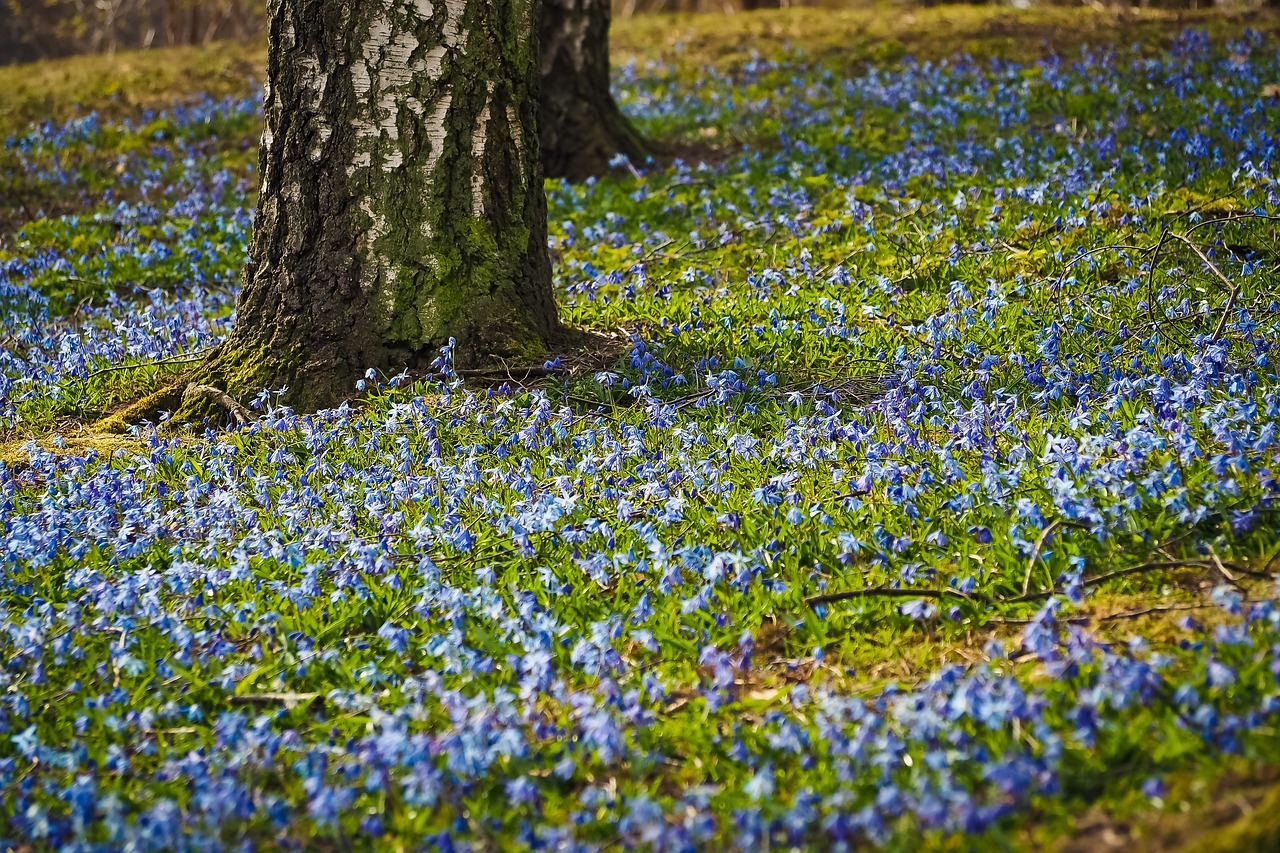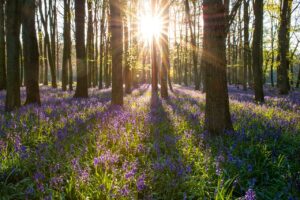Bluebell
Overview
The Bluebell plant, or Hyacinthoides non-scripta, is a charming perennial herb celebrated for its striking violet-blue, bell-shaped flowers that herald the arrival of spring. Belonging to the Asparagaceae family, it thrives in partial shade with well-drained soil and enchants with a lovely sweet fragrance, making it a treasured ornamental addition to any garden.

Characteristics
Known for its violet-blue, bell-shaped, sweet-scented flowers and ability to thrive in shady conditions.
Region
The Bluebell plant is native to the British Isles and commonly found throughout Europe, in woodlands and shady areas.
Natural Habitat
The Bluebell plant is usually found in woodlands and sometimes in shady hedgerows.
Cultivation
Thrives in well-drained, sandy soil with medium moisture, preferring sun-dappled part shade but tolerates full sun to full shade.
Uses and Benefits
The Bluebell plant is treasured for its vibrant blue-violet flowers that carpet woodlands each spring, signifying the season’s full bloom5. Not just a feast for the eyes, its sweet fragrance is also a treat, inviting a sensory stroll through the blossoms3. Exceptionally, you may come across rare white or soft pink variations, adding a delicate twist to the usual sea of blue4. While mostly celebrated for its beauty and aroma, the Bluebell remains mainly an ornamental gem, with no widely recognized medicinal or culinary uses. The plant’s non-utility aspects, however, do not diminish its value as a herald of spring’s arrival.
Whether in quaint cottage gardens or grand woodland settings, the allure of bluebells continues to captivate the hearts of nature lovers and gardeners alike.

Cultivation Tips
Cultivating the enchanting bluebell plant is a delightful way to herald spring. For a successful bloom, plant your bluebell bulbs about 3-4 inches deep and space them 4-6 inches apart when autumn whispers its way into the year2.
These charming plants are quite the natural crowd-pleasers as they happily multiply by bulb offsets and don’t shy away from self-seeding when conditions are just right2. Each gentle nod of their trumpet-shaped blooms stands over a cluster of green, with clumps reaching heights of 12 to 18 inches. Watch as the bluebells sway gracefully, wide at three to eight inches, transforming your garden into a springtime symphony of color5.
Seasonal Considerations
In the rhythm of the seasons, Bluebell plants graciously mark the time with their presence. As the days grow warmer in mid to late spring, these perennials unfurl their palette of violet-blue blooms, charming all who witness their display. This vivid dance of color can last a generous five weeks, inviting onlookers to pause and relish in the ephemeral beauty.
But as the fleeting nature of spring’s blossoms holds, the Bluebell nods to summer’s approach by gracefully entering dormancy. So by the time early summer whispers through the trees, the Bluebell has retreated once more, leaving behind the promise to return with the next cycle of sun and rain5.

Issues and Troubleshooting
Troubleshooting the care of Bluebell plants can sometimes be necessary, even though they are generally hardy once established. For starters, if your Bluebell flowers are failing to bloom or appear stunted, it could signal poor soil conditions. They prefer rich, well-drained soil, so ensure that the earth is not too compacted or waterlogged2. Overcrowding can also be an issue, as Bluebells need space to spread their leaves and flowers; consider dividing the clumps every few years if they seem too dense2.
If you notice the leaves yellowing or the flowers wilting prematurely, this could be a sign of too much direct sunlight or a lack of moisture—Bluebells enjoy dappled shade and consistent moisture, especially during their growth period in the spring2. In areas with very hot or dry summers, mulching can help retain soil moisture and keep the bulbs cool. Pests and diseases are relatively rare in Bluebells, but watch out for snails and slugs, which may be attracted to the tender leaves1.
By addressing these common issues with sensitivity and care, your Bluebell herbs should continue to thrive and grace your garden with their charming, sweet-scented bells every spring.
History and Folklore
Enchanting and shrouded in a tapestry of tales, the Bluebell herb has long captivated the imagination. Its history stretches across the woodlands of Europe, with folklore nestling within every nodding bloom. Known as Hyacinthoides non-scripta, it’s said that a field of Bluebells is intricately woven with fairy enchantments, a place where magic is as real as the sweet perfume that fills the spring air.
Legend whispers that to tread on Bluebells would spirit one away to the fairy realm, never to return. These blossoms were also thought to ring out with the peals of fairy church bells, calling to the creatures of the otherworld. Yet, it’s not just fairies that are drawn to the Bluebell’s charm; in the language of flowers, they speak of constancy and everlasting love, hinting at the depth of stories wrapped around their slender stems.
While documented history and folklore pertaining directly to the Bluebell are sparse, the plant carries a mystique that threads throughout cultural myths and poetic lore, maintaining its mystical allure through the ages3.
References
1. https://www.woodlandtrust.org.uk/trees-woods-and-wildlife/plants/wild-flowers/bluebell/
2. https://www.missouribotanicalgarden.org/PlantFinder/PlantFinderDetails.aspx?kempercode=q740
3. https://en.wikipedia.org/wiki/Hyacinthoides_non-scripta
4. https://www.kew.org/plants/bluebell
5. https://www.thespruce.com/growing-english-bluebells-5094292
Image Credit: 652234
Image Credit: kretktz
Image Credit: herbert2512
Nicolas Duval
Nicolas is a passionate advocate for nature and the art of wildcrafting. His dedication shines through in Wildcraftia, a website he meticulously crafted to serve as a haven for nature enthusiasts worldwide. Driven by a deep appreciation for nature’s connection to humanity, Nicolas embarked on his journey in 2011 with SmokableHerbs, a platform showcasing his love for nature’s bounty. Building upon this foundation, he established Smokably, a thriving online store offering premium herbs and blends to a global audience.
